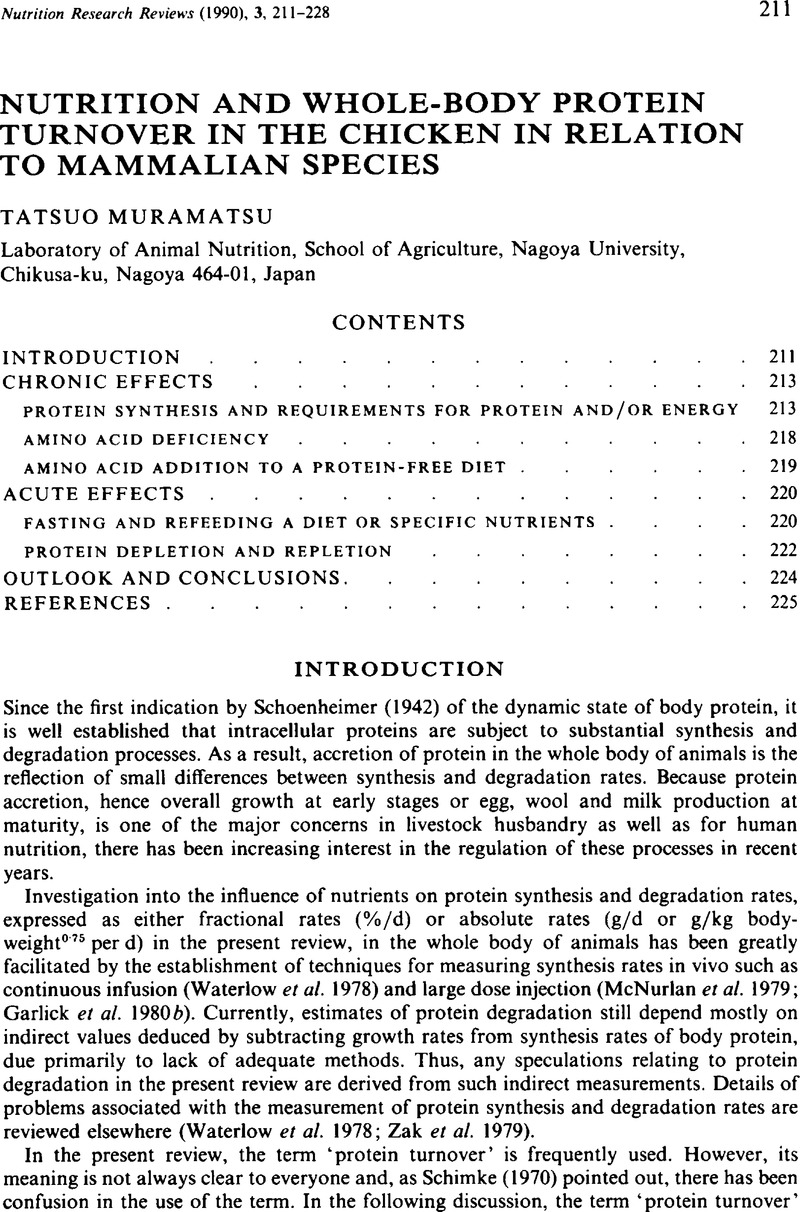Crossref Citations
This article has been cited by the following publications. This list is generated based on data provided by Crossref.
Young, V. R.
1991.
Nutrient interactions with reference to amino acid and protein metabolism in non-ruminants; particular emphasis on protein-energy relations in man.
Zeitschrift für Ernährungswissenschaft,
Vol. 30,
Issue. 4,
p.
239.
Kita, K.
Muramatsu, T.
and
Okumura, J.
1993.
Effect of dietary protein and energy intakes on whole-body protein turnover and its contribution to heat production in chicks.
British Journal of Nutrition,
Vol. 69,
Issue. 3,
p.
681.
Butts, Christine A
Moughan, Paul J
Smith, William C
and
Carr, David H
1993.
Endogenous lysine and other amino acid flows at the terminal ileum of the growing pig (20 kg bodyweight): The effect of protein‐free, synthetic amino acid, peptide and protein alimentation.
Journal of the Science of Food and Agriculture,
Vol. 61,
Issue. 1,
p.
31.
Schulze, Hagen
Butts, Christine A
Moughan, Paul J
and
Verstegen, Martin W A
1995.
The 15N‐isotope dilution method for determining ileal endogenous nitrogen excretion in the young (10 kg liveweight) pig.
Journal of the Science of Food and Agriculture,
Vol. 69,
Issue. 1,
p.
41.
Tesseraud, S.
Peresson, R.
Lopes, J.
and
Chagneau, A.M.
1996.
Dietary lysine deficiency greatly affects muscle and liver protein turnover in growing chickens.
British Journal of Nutrition,
Vol. 75,
Issue. 6,
p.
853.
Tesseraud, S.
Maaa, N.
Peresson, R.
and
Chagneau, A. M.
1996.
Relative responses of protein turnover in three different skeletal muscles to dietary lysine deficiency in chicks1.
British Poultry Science,
Vol. 37,
Issue. 3,
p.
641.
Moughan, P.J.
Souffrant, W.B.
and
Hodgkinson, S.M.
1998.
Physiological approaches to determining gut endogenous amino acid flows in the mammal.
Archiv für Tierernaehrung,
Vol. 51,
Issue. 2-3,
p.
237.
Akiba, Yukio
2001.
Potential of Nutrition in the Control of Growth and Meat Quality in Broilers..
The Journal of Poultry Science,
Vol. 38,
Issue. 1,
p.
67.
Bigot, Karine
Taouis, Mohammed
Picard, Michel
and
Tesseraud, Sophie
2003.
Early post-hatching starvation delays p70 S6 kinase activation in the muscle of neonatal chicks.
British Journal of Nutrition,
Vol. 90,
Issue. 6,
p.
1023.
Hodgkinson, Suzanne M
and
Moughan, Paul J
2003.
The enzyme hydrolysed protein method for the determination of endogenous ileal nitrogen and amino acid flows—a modification.
Animal Feed Science and Technology,
Vol. 108,
Issue. 1-4,
p.
207.
Tesseraud, Sophie
Abbas, Mourad
Duchene, Sophie
Bigot, Karine
Vaudin, Pascal
and
Dupont, Joëlle
2006.
Mechanisms involved in the nutritional regulation of mRNA translation: features of the avian model.
Nutrition Research Reviews,
Vol. 19,
Issue. 1,
p.
104.
Tesseraud, Sophie
Métayer, Sonia
Duchêne, Sophie
Bigot, Karine
Grizard, Jean
and
Dupont, Joëlle
2007.
Regulation of protein metabolism by insulin: Value of different approaches and animal models.
Domestic Animal Endocrinology,
Vol. 33,
Issue. 2,
p.
123.
Hocquette, J.F.
Tesseraud, S.
Cassar-Malek, I.
Chilliard, Y.
and
Ortigues-Marty, I.
2007.
Responses to nutrients in farm animals: implications for production and quality.
Animal,
Vol. 1,
Issue. 9,
p.
1297.
Bouvarel, I.
Chagneau, A.M.
Lescoat, P.
Tesseraud, S.
and
Leterrier, C.
2008.
Forty-Eight-Hour Cycle Sequential Feeding with Diets Varying in Protein and Energy Contents: Adaptation in Broilers at Different Ages.
Poultry Science,
Vol. 87,
Issue. 1,
p.
196.
Métayer, Sonia
Seiliez, Iban
Collin, Anne
Duchêne, Sophie
Mercier, Yves
Geraert, Pierre-André
and
Tesseraud, Sophie
2008.
Mechanisms through which sulfur amino acids control protein metabolism and oxidative status.
The Journal of Nutritional Biochemistry,
Vol. 19,
Issue. 4,
p.
207.
Golian, A.
Guenter, W.
Hoehler, D.
Jahanian, H.
and
Nyachoti, C.M.
2008.
Comparison of Various Methods for Endogenous Ileal Amino Acid Flow Determination in Broiler Chickens.
Poultry Science,
Vol. 87,
Issue. 4,
p.
706.
Tesseraud, Sophie
Bouvarel, Isabelle
Collin, Anne
Audouin, Estelle
Crochet, Sabine
Seiliez, Iban
and
Leterrier, Christine
2009.
Daily Variations in Dietary Lysine Content Alter the Expression of Genes Related to Proteolysis in Chicken Pectoralis major Muscle.
The Journal of Nutrition,
Vol. 139,
Issue. 1,
p.
38.
Everaert, Nadia
Swennen, Quirine
Coustard, Sonia Métayer
Willemsen, Hilke
Careghi, Christine
Buyse, Johan
Bruggeman, Veerle
Decuypere, Eddy
and
Tesseraud, Sophie
2010.
The effect of the protein level in a pre-starter diet on the post-hatch performance and activation of ribosomal protein S6 kinase in muscle of neonatal broilers.
British Journal of Nutrition,
Vol. 103,
Issue. 2,
p.
206.
DUNSTAN, G.A.
2010.
A simple model for the determination of the relative utilization efficiency of protein by blacklip abalone (Haliotis rubraLeach).
Aquaculture Nutrition,
Vol. 16,
Issue. 1,
p.
1.
Tesseraud, S.
Everaert, N.
Boussaid-Om Ezzine, S.
Collin, A.
Métayer-Coustard, S.
and
Berri, C.
2011.
Manipulating tissue metabolism by amino acids.
World's Poultry Science Journal,
Vol. 67,
Issue. 2,
p.
243.



